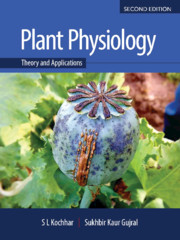Book contents
- Frontmatter
- Contents
- Foreword
- Preface to the Second Edition
- Preface to the First Edition
- Acknowledgements
- Some Common Abbreviations used in the Text
- Abbreviations for Units
- Unit I Water and Mineral Translocation in Plants
- Unit II Metabolism and Bioenergetics
- Unit III Growth and Development
- Unit IV Physiological Stress and Secondary Metabolites – Their Role in Metabolism
- Unit V Crop Physiology – An Innovative Approach
- Unit VI Breakthroughs in Plant Physiology
- Unit VII Some Experimental Exercises
- Glossary
- References
- Index
- Colour Plates
Chapter 7 - Photosynthesis
Published online by Cambridge University Press: 12 May 2020
- Frontmatter
- Contents
- Foreword
- Preface to the Second Edition
- Preface to the First Edition
- Acknowledgements
- Some Common Abbreviations used in the Text
- Abbreviations for Units
- Unit I Water and Mineral Translocation in Plants
- Unit II Metabolism and Bioenergetics
- Unit III Growth and Development
- Unit IV Physiological Stress and Secondary Metabolites – Their Role in Metabolism
- Unit V Crop Physiology – An Innovative Approach
- Unit VI Breakthroughs in Plant Physiology
- Unit VII Some Experimental Exercises
- Glossary
- References
- Index
- Colour Plates
Summary
Photosynthesis is by far the most significant biological process on the planet earth. It is through this phenomenon that all the useful organic matter available on earth has been produced. The leaves in the higher plants may be regarded as machinery engineered to undertake photosynthesis efficiently even under very hostile environments. Photosynthesis is not a monopoly of green plants but it also occurs in cyanobacteria and photosynthetic bacteria.
Photosynthesis can be defined as the anabolic process during which complex energy-rich organic molecules/compounds are synthesized by organisms from CO2 and H2O using solar energy. Every day, the radiant energy of the sun that bombards the earth equals nearly a million Hiroshima-sized atomic bombs. Out of the total supply of solar energy received by the earth, only 1–2 per cent is utilized by photosynthesis.
In higher and other non-flowering plants, the photosynthetic reactions occur in the ‘chloroplast – an incredible thermodynamic machine’.
Photosynthesis occurs in three steps (Figure 7.1):
1. To harness solar energy by the chloroplasts
2. Using this solar energy to produce ATP and NADPH in the light reaction
3. Using the ATP and NADPH to power the synthesis of complex organic molecules using atmospheric CO2 during the dark reaction
The following equation summarizes the overall process:
Historical Perspective
The beginnings of photosynthetic research can be traced back to approximately 300 years. The idea that water is an important reactant emerged from the experiments of a Dutch alchemist, Van Helmont (1648). The first account of photosynthesis appeared in the writings of Stephen Hales, an English naturalist and the ‘Father of plant physiology’. Hales (1727) postulated that plants receive a large part of their nutritional requirements from the air but the role of light was not recognized at that time. Joseph Priestley (1772) demonstrated that plants have the capacity to purify air. His experiments excited Jan Ingenhousz who in 1773 noticed that photosynthesis will occur in the presence of sunlight and only the green parts of the plant purified air. But neither of them was aware of the chemical nature of pure or impure air.
- Type
- Chapter
- Information
- Plant PhysiologyTheory and Applications, pp. 201 - 252Publisher: Cambridge University PressPrint publication year: 2020



